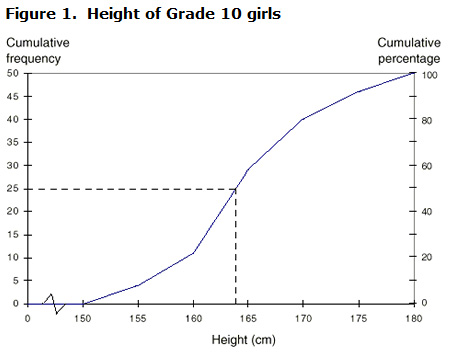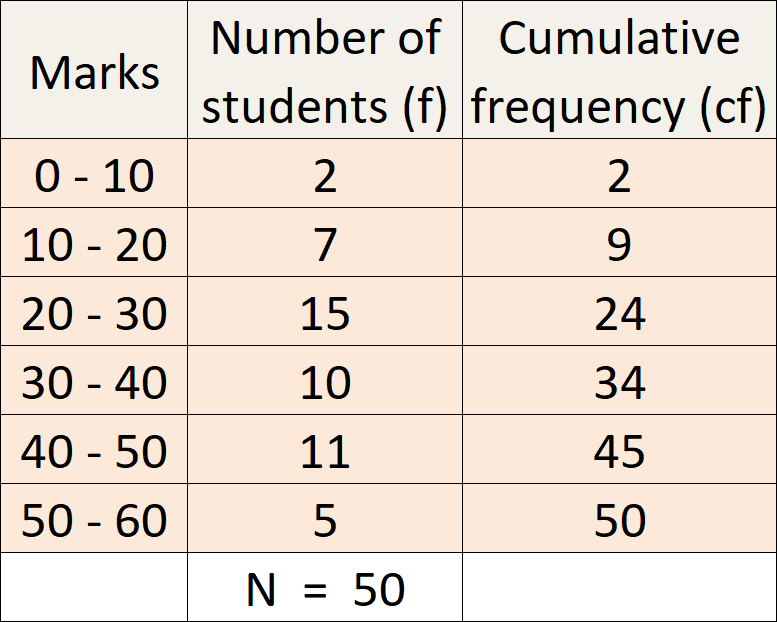How To Find The Median Value In A Frequency Table
Find the mean by adding the two numbers and dividing by 2. Nuestro principal objetivo radica en impulsar el bienestar de nuestros clientes ofertándoles diferentes soluciones financieras personalizadas que hagan posibles sus proyectos.
 Mean Median And Mode Of Grouped Data Frequency Distribution Tables Statistics Youtube
Mean Median And Mode Of Grouped Data Frequency Distribution Tables Statistics Youtube
To find the mean add all the ages together and divide by the total number of children.

How to find the median value in a frequency table. If n is even then the median is the average of the n2-th and the n2 1- th value. To find the Median Alex places the numbers in value order and finds the middle number. Now we can calculate the median.
The median since n 12412205 the median is the average of the 20th and 21st data values when they are listed in order. In a frequency table the observations are already arranged in an ascending order. It is a little bit different if you have to find the mean when given a frequency table.
The median is the 55 th number which is the mean of the 5 th number 6 and the 6 th number 7. Add another column onto the table labelled Cumulative Frequency. In a discrete frequency distribution table statistical data are arranged in an ascending order.
If the total number of occurrences lets call it n ie. Calculate a running total of the. The class containing the median value.
The median is the middle value in an ordered set of data. 2 Find the entry in the bottom row of the Cumulative Frequency column. Using the formula for median we have Median or where lower class boundary of the median class total frequency less than type cumulative frequency corresponding to frequency of the median class and class width of the median class.
In this case the median is the 11 th number. 53 55 56 56 58 58 59 59 60 61 61 62 62 62 64 65 65 67 68 68 70 Median 61. For each row of the table add the entries in the Frequency column up to that row.
This is as shown in figure 1 above where we have the values in column A and their frequencies in column B. The sum of the frequencies the total number of students is odd then the median is the n1 2-th value. We can see that the 20th and 21st data values in order are both 75.
Note that the data set contains 43 values. Median Median time spent on internet by the students is Median N 2 t h value 56 2 t h value 28 t h value The cumulative frequency just greater than or equal to 28 is 30. Put the results in numerical order in a frequency table this will already be done Count the total amount of results and add one Divide this by 2 to.
In the table the blue numbers show us accumulated frequency values or the cumulative frequency. Remember when you are working out the median. For us to get the median of values in a frequency table we first need to tabulate our table with the values and the number of times the values occur.
It can be helpful to see these. 2 then divide by the total number of items in the data set. Median 6 7 2 13 2 65.
Next lets determine the mode which we can find by looking for the largest frequency value. Multiply midpoints by frequencies and add the sub-totals. To calculate the median for a frequency table we need to follow this logic.
We can obtain the median by looking for the value in the middle position. If you type all those ages into a calculator it is easy to make an error. According to the table the mode of the data is 39.
If there is an odd number of data then median is the middle number. You have to first calculate the total score of everything but the frequency table helps us to quickly calculate the total sum. If is odd we will have one middlemost value of the variable which will be the median.
For frequency distribution of a discrete variable to find the median we have need to look at the total frequency. How To Find The Mean Mode And Median From A Frequency Table For Both Discrete And Grouped Data. Lets rewrite the table with a cumulative frequency column.
1 add all of the numbers to find the sum of the whole data set. If there is an odd number of observations the median is the middle number. Divide by the total of the frequencies.
In other words 2995-3995 is the median class ie. If there is an even number of data then median will be the mean of the two central numbers. The median is therefore the 22nd value.
Find the largest frequency - the corresponding value is the modal value or modal class.
 Median From A Frequency Table Corbettmaths Youtube
Median From A Frequency Table Corbettmaths Youtube
 Mean And Mode From The Frequency Table Video Lessons Examples Solutions
Mean And Mode From The Frequency Table Video Lessons Examples Solutions
 The Modal And Median Class From Grouped Data Youtube
The Modal And Median Class From Grouped Data Youtube
 Median From The Frequency Table Video Lessons Examples Solutions
Median From The Frequency Table Video Lessons Examples Solutions
 How To Find Mean Median And Mode From Frequency Table Youtube
How To Find Mean Median And Mode From Frequency Table Youtube
 Finding The Position Of The Median Add One Or Not Youtube
Finding The Position Of The Median Add One Or Not Youtube
 4 Median From A Grouped Frequency Table Youtube
4 Median From A Grouped Frequency Table Youtube
 Averages Median From Grouped Frequency Table Grade 4 Onmaths Gcse Maths Revision Youtube
Averages Median From Grouped Frequency Table Grade 4 Onmaths Gcse Maths Revision Youtube
 Calculating Mean Median Mode From Frequency Distribution Youtube
Calculating Mean Median Mode From Frequency Distribution Youtube
 Statistics Power From Data Calculating The Median
Statistics Power From Data Calculating The Median
 Finding Median For Grouped Data
Finding Median For Grouped Data
 Calculating Mean Median Mode And Range From A Frequency Table 7 Alamandamaths
Calculating Mean Median Mode And Range From A Frequency Table 7 Alamandamaths
 How To Find Median Of A Continuous Frequency Distribution Youtube
How To Find Median Of A Continuous Frequency Distribution Youtube
 Median From Group Data With Mid Value And Frequency Youtube
Median From Group Data With Mid Value And Frequency Youtube
 How To Find The Median Of A Discrete Frequency Distribution Youtube
How To Find The Median Of A Discrete Frequency Distribution Youtube
 Median In A Histogram Summarizing Quantitative Data Ap Statistics Khan Academy Youtube
Median In A Histogram Summarizing Quantitative Data Ap Statistics Khan Academy Youtube
 Frequency Tables Median Statistics Probability Maths Fuseschool Youtube
Frequency Tables Median Statistics Probability Maths Fuseschool Youtube
 Median Statistics Videos Concepts And Methods With Examples
Median Statistics Videos Concepts And Methods With Examples
Mean Median Mode For Grouped Data Passy S World Of Mathematics
Post a Comment for "How To Find The Median Value In A Frequency Table"